Electricity and fuels that are consumed by the combined terminal have very large impact on operating costs and the amount of harmful emissions. Both parameters are of key importance today for assessing the terminal’s operational efficiency and it seems that this importance will grow in the future. Hence, terminals use a monitoring system of energy consumed, which is often part of the Environmental Management System (EMS) implemented by terminal operator. Available publications on this subject relate mostly to terminals in seaports but may also be used in the analysis of combined terminals. The same container handling equipment is used in port container terminals and combined terminals, and the same transshipment technologies for handling land and river transport means are used.
In research carried out in 2016 in a group of 91 European ports, as many as 80% of them implemented a system of continuous energy monitoring, which means an increase of 9% compared to 2013. Moreover, the reduction of fuel and electricity consumption belong to the three top environmental priority areas in terminal management next to the air quality and noise reduction activities. Appropriate tools for monitoring, reporting, and optimization of energy consumption, often integrated with Terminal Operating Systems (TOS), are used in both seaport and inland terminals.
The starting point for any analysis and optimization is the knowledge of the volume and structure of electricity and fuel consumption generated by the terminal. Based on data from seaport container terminals, we can distinguish the following basic areas of energy consumption at the combined terminal:
- Electricity for:
- handling equipment (Rail Mounted Gantries—RMGs, Ship-to-Shore crane—STS, Rubber Tired Gantries—RTGs, Empty Container Handlers—ECHs, Terminal Tractors—TTs),
- storage yard lighting,
- offices, and
- container reefers.
- Liquid fuels (diesel oil, LNG, LPG) for:
- handling equipment (Reach Stackers – RSTs, RTGs, ECHs, TTs),
- locomotives,
- terminal staff cars, and
- client trucks.
In the group of terminal handling equipment, replacement of classic diesel engines with electrically assisted drives, i.e., hybrid (diesel-electric) or fully electric (Figure 8.4-8.6) is observed. Another trend is the use of dual-fuel (diesel-gas) engines or powered exclusively with alternative fuels (LNG, CNG, LPG, and Hydrogen). This applies in particular to RTGs, ECHs and TTs handling units. The biggest challenge in this respect seems to be changing the Reach Stacker (RST) diesel engine, which is characterized by an extremely demanding work regime. This challenge was taken up as part of the H2Ports project that aims to develop a zero-emission eRST featuring a hydrogen fuel cell on board. The new Reach Stacker is expected to enter operation in 2021 at the MSC Terminal Valencia (MSCTV) in Spain[1].
[1] Hyster begins development of electric reachstacker for Port of Valencia, https://moveitmagazine.com/2019/03/22/
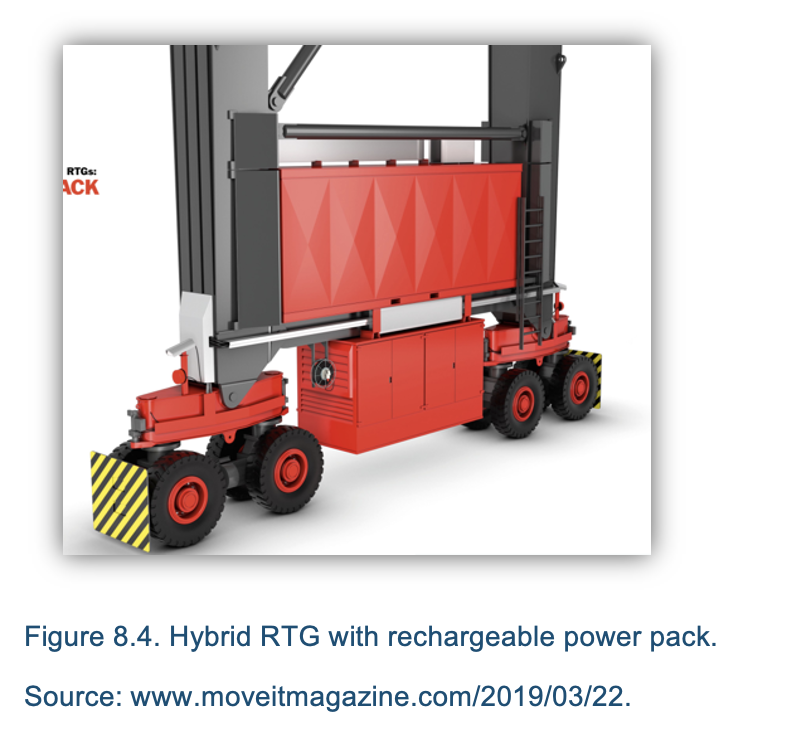
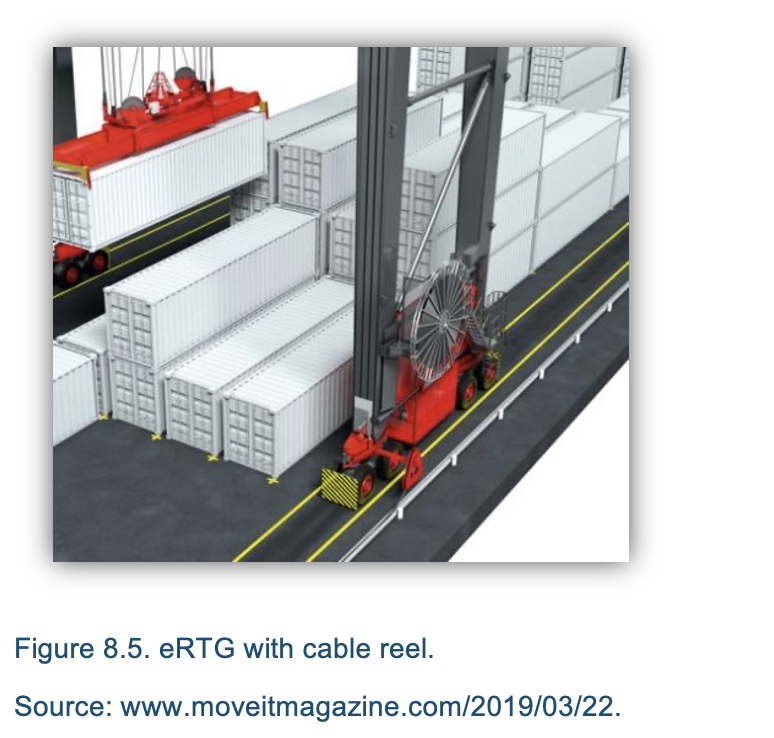
There is a huge capacity of energy transition from fossil fuels to alternative fuels and electric power for all handling equipment. Creates a simple way to achieve the strategic goal, which is “zero emission CT terminal” which would be completely neutral for the environment and society. This goal can be achieved by 2025.
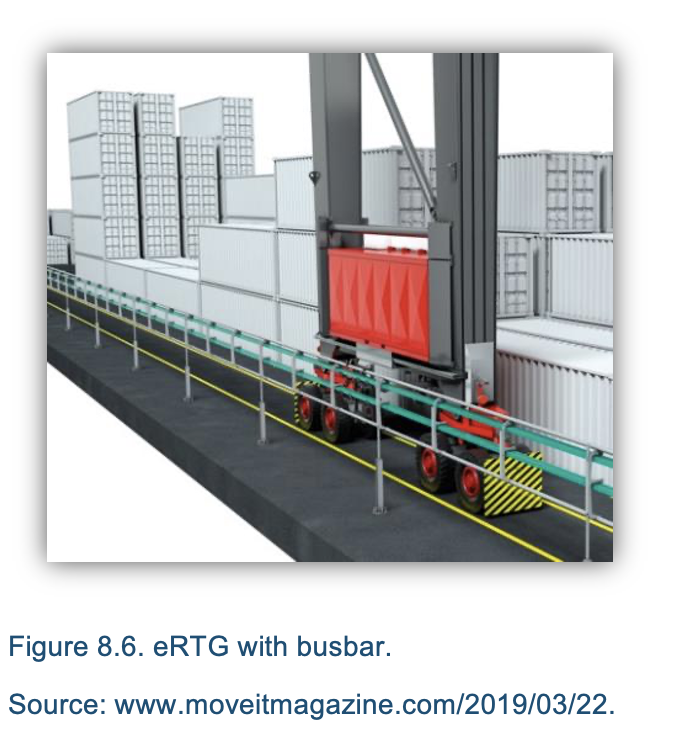
The structure of electric energy and fuel consumption is always related to the specificity of the terminal infrastructure and equipment as well as the volume of transshipments. The differences would be large even within the terminals of the same operator similarly equipped. The available data on energy management of seaport container terminals shows that two container terminals at the Port of Gdansk have completely different approaches to the energy sources used. The larger Deepwater Container Terminal (DCT) has a 54% share of electrically powered transshipment facilities, and at the smaller Gdansk Container Terminal (GTK) this share is equal to zero. The average number of electrical transshipment devices in five Polish container terminals is 41% (Blue Baltics, 2020; Go LNG, 2020; ICF, 2020). Data for container terminals in other countries show that this share has similar values, i.e., 34% for Rotterdam and 53% for ports in Finland.
The energy balance for a typical rail-road terminal will be presented below (Figure 8.7). The assumption is that this is a new terminal with a reloading capacity of 130,000 ITU equipped with: one eRTG, two RSTs and two TTs with semitrailers (adapted for the transport of containers and semitrailers). The infrastructure of the terminal with a total area of 6 ha includes: load tracks with a length of 650 m, storage yards of about 30,000 m2, seven power supply points for refrigerated containers, an office and social building with a usable area of about 250 m2, a workshop of 3,000 m3 space area, parking lots, a covered shed and washing point.
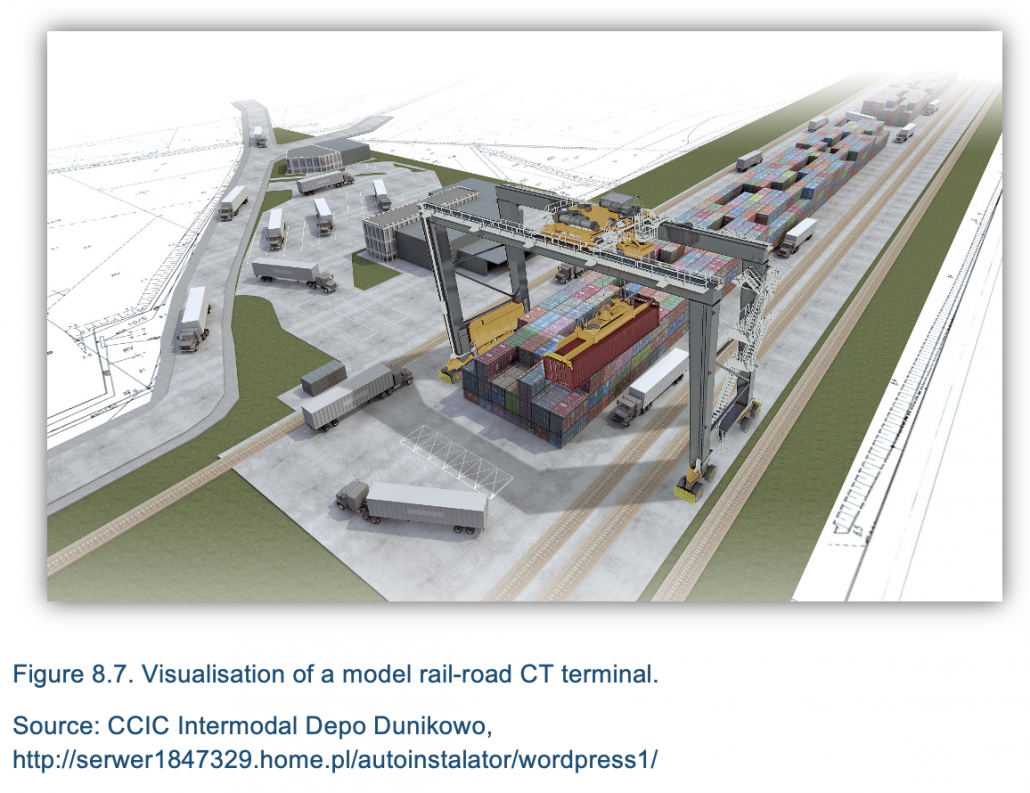
Table 8.9. presents basic data determining the energy demand of basic infrastructure elements and handling devices of the model combined terminal. Based on these data, you can calculate the daily, monthly or annual energy demand including fixed and variable consumption. For example, for the adopted model of rail-road combined terminal, the estimated total fixed annual energy demand is equal to 390,000 kWh/year. This figure considers seasonal fluctuations in energy demand during one year of operation, e.g., no heating and shorter daily lighting time during the summer.
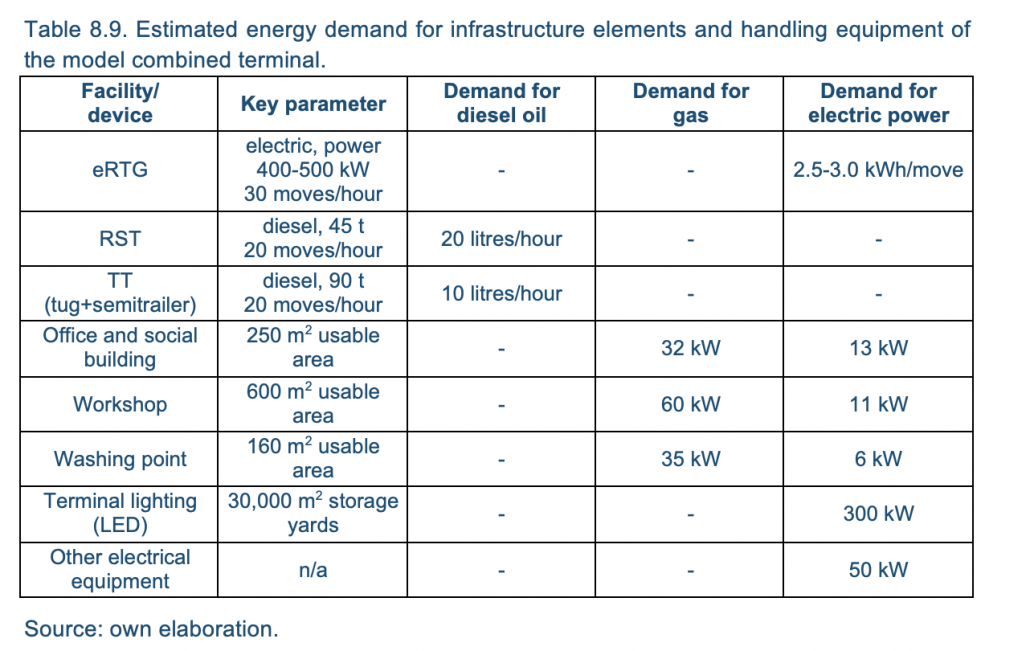
Variable demand is proportional to the volume of transshipments. We will calculate them by multiplying the unit energy consumption by the number of intermodal units handled or by the number of movements performed by the primary handling equipment of the terminal (Table 8.10)[1].
The obtained results show that the variable energy demand of the model terminal ranges from 887,500 kWh to 3,747,500 kWh depending on the transshipment volume. Hence the total fixed and variable energy demand of this terminal ranges from 1.28 MWh to 4.13 MWh (Table 8.11). On this basis, a marginal consumption can be calculated, which in the case of the model terminal is 25.6 ÷ 31.8 kWh per ITU. It should be remembered that only part of this demand relates to pure electricity, i.e., 5.8 ÷ 10.6 kWh per ITU. Importantly, the structure of unit electricity is less favorable when transshipment volume increases and the share of handling movements done with diesel-powered devices, i.e., RSTs and TTs, increases. This last parameter is consistent with research studies related to energy consumption of seaport container terminals. They indicate average electric energy consumption values 5.00 ÷ 7.25 kWh/move (Delft, 2014).
[1] The relationships between the trans-shipment volume and the number of movements of primary handling equipment were adopted on the basis of publication: S. D. Stoilova, S. V. Martinov, Choosing the container handling equipment in a rail-road intermodal terminal through multi-criteria methods, Materials Science and Engineering 664 (2019)

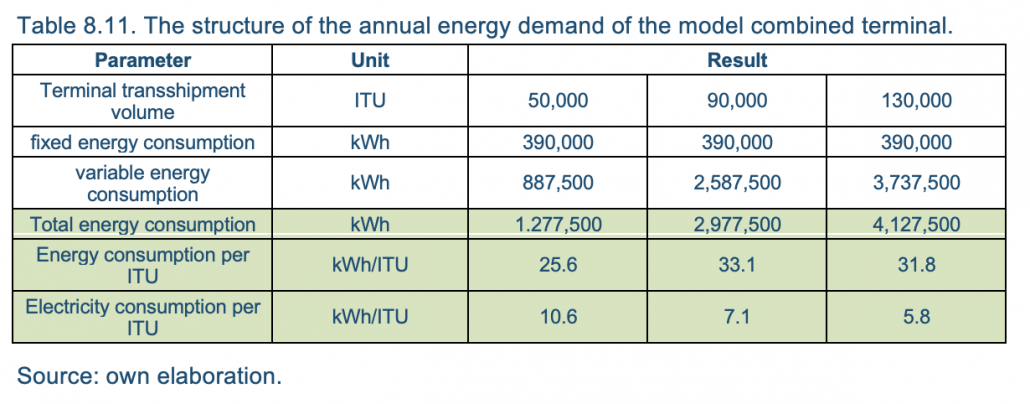
In conclusion, the vast potential for energy efficiency measures existing in the area of terminal infrastructure and handling equipment should be emphasized. The main trends in the energy management of terminals are identified below.
- The most significant potential for energy saving in infrastructure includes low-energy yard lighting, passive/low energy office buildings, efficient heating systems;
- Handling equipment should be powered by electricity, alternative fuels and hybrid systems in drives,
- Terminals possess favorable conditions for operating Renewable Energy Sources (RES) technologies including producing renewable energy in the terminal area;
- Terminal area can be used for provision LNG/CNG/electrical charging infrastructure;
- Conditions (e.g., terminal gate systems, TOS) for efficient train and trucks servicing and handling (e.g., slot system) should be applied;
- Incentive scheme rewarding carriers and operators that uses less energy and/or alternative energy sources should be applied.
Energy consumption and efficiency criteria and good operational practices should be incorporated in tendering procedures associated with terminal investments.